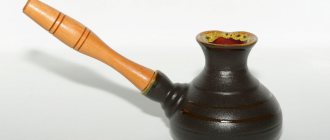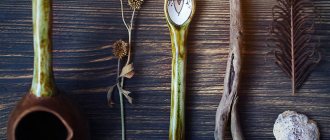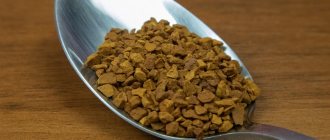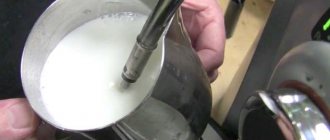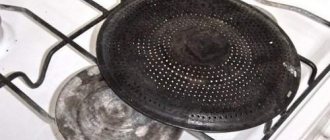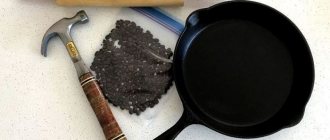The history of the emergence of ceramic Turks
The history of the appearance of utensils for brewing coffee is several hundred years old. It is believed that coffee was originally prepared by African nomadic tribes. The drink was brewed in copper pots over a fire. Gradually, the containers were modified for ease of use: the neck of the vessel became narrower, the handle was longer. This made it possible not to spill the drink on the coals and to hold the cezve more securely in your hands.
Such a vessel was brought to the Russian Empire from Turkey and called Turka
To this day, Turks are used not only from copper, but also from clay and ceramics. Since ancient times, humanity has created ceramic products: jugs, dishes, tiles. Ceramic Turks are made from fired clay and covered with a matte or glossy glaze.
Differences and similarities with a clay Turk
Ceramics and clay are the same material with different processing. A pottery pot made of clay does not have a finishing coating - “glaze”, which makes ceramic dishes smooth and shiny.
The porous surface of the clay absorbs smell and color. The taste of new coffee from a clay pot may contain shades of the previous drink. You can prepare another type of coffee in it, but its taste will be distorted.
Caring for clay dishes is more difficult than ceramic ones. Inaccurate washing will quickly ruin the appearance of the product.
Advantages and disadvantages of ceramic Turks
The drink cools slowly in the Turk.
Ceramic cookware guarantees high quality brewed coffee. Unlike copper, it has a number of advantages:
- Allows you to enjoy the true taste without unnecessary impurities, as it does not retain traces of the aroma of previous brewings of the drink. For lovers of flavored, blended coffee varieties, this is the best option.
- The thickened walls of the Turk and the wide bottom allow you to gradually reveal the taste and aroma of the drink due to the uniform distribution of heat.
- Easy to care for, easy to clean.
- Eco-friendly and safe for human health.
When choosing a cezve, you should pay attention to some disadvantages of ceramics:
- Unlike copper, it is more fragile and breaks easily.
- With a sharp temperature change, it breaks its integrity.
Ceramic coffee pot: features and benefits
First of all, let's define the terms. In the assortment of stores you can find clay and ceramic Turks. As we know, ceramics is the same as clay. In this case, why do products made from the same material have different names?
Clay Turk
- A clay Turk is made from baked but not glazed clay.
- A clay pot perfectly absorbs odors and tiny oily particles that coffee is so rich in. Then, upon subsequent use, they are mixed with the aroma of the fresh drink. This has its own charm, which is greatly appreciated by connoisseurs. The older such a Turk, the more valuable it is, the richer the aroma of the drink that is prepared in it.
Ceramic Turk
- Unlike a porous clay cezve, a ceramic product must have a dense finishing coating. It can be glossy, but more often you will find a matte finish. This is exactly the texture that is in fashion now.
- The coating gives the ceramic Turk properties that are very valuable and convenient for us, ordinary consumers. Due to its high degree of inertness, ceramics practically do not interact with the environment. This means that the material does not oxidize, does not absorb odors, and does not stain.
If you want to enjoy pure taste, without any impurities, or you are a fan of experimenting with different varieties and mixtures of grains, then a ceramic pot will help you prepare a drink with unclouded taste characteristics. A ceramic cezve does not retain the aromas of previous brews, so you can even prepare compound or flavored coffees in it.
A ceramic pot ensures high quality of the finished drink. Thick walls and a wide bottom help the heat to be evenly distributed over the entire area of the vessel, gently revealing the aroma and taste of the coffee being prepared.
Features of ceramic Turks
When working with a ceramic Turk, you need to remember one feature: the thermal conductivity of ceramics is much lower than copper. Therefore, the ceramic Turk heats up much more slowly. It also cools down slowly. When you remove it from the heat, it remains so hot for a few seconds that the coffee continues to rise. Therefore, when brewing coffee in a ceramic pot, it is very important to prevent the foam from rising to the edge. If you bring the process to the point where the top becomes light caramel, you risk escaped coffee.
IMPORTANT. Coffee in a ceramic Turk should be removed from the heat before the foam cap rises to the edge, since the ceramic retains heat for a long time and heats the liquid for a few seconds after the contact with the stove ceases.
Ceramic Turks are either handmade or industrially produced. In the latter case, the product will have a warranty. A home-made ceramic Turk may not be as reliable. But such cezves have an inescapable charm, and supporters of the wave theory will definitely feel the kind and positive energy that characterizes all handmade things.
Recipe for making coffee in a ceramic pot
The burner or surface of the stove should allow the Turk to stand level and provide uniform heating of the vessel.
Preparing coffee in a ceramic Turk has a number of features that are important to consider.
- Before brewing coffee, you need to boil water in a kettle.
- Pour into a small saucepan as much water as you need to make coffee. Place on low heat.
- Pour boiling water from a kettle into a ceramic pot and let it heat up. Pour out the water and heat the Turk evenly over the fire, carefully turning it sides. This results in drying and additional heating of the turk.
- After this, you need to quickly pour ground coffee into the coffee pot, add sugar to taste and mix with a dry spoon. Pour the water that has just boiled at this point from a small saucepan into the Turk and put it on low heat.
- When foam appears on the surface and the coffee begins to rise, remove from heat and pour into cups.
Natural brewed coffee, prepared in a Turk, increases activity, invigorates, and improves digestion. Biological substances contained in grains improve metabolism and increase the body's antioxidant defense.
Reviews about ceramic Turks
Theoretical knowledge becomes much more convincing when supported by practical evidence. That is why we interviewed several familiar ceramics owners who had already acquired a fashionable new item. Here's what they say about the ceramic cezve.
Oksana, experience using a ceramic Turk for 3 weeks.
- Convenient, simple, easy. What I like most is that it is so pleasant to the touch, smooth and even a little warm. But I’m always afraid that my cat will drop it from the table; my kitchen floor is made of tiles. That's why I keep it in the kitchen cabinet.
- Coffee? It turns out very tasty. It even reminds me of Turkish, which is boiled in sand. Some additional warm note has appeared in the taste since I started preparing the drink in a ceramic pot.
Dina, experience using a ceramic Turk for 6 months
— It’s a beautiful thing, but I quickly got used to it. I have a whole collection of Turks - copper, clay, and now I have ceramic ones too. I prefer my old copper one, brought from Egypt in 1900, to everything else.
— There were no problems with use, I am an experienced coffee lover, so I knew about the nature of the ceramic cezve in advance. The trick is to remove it from the heat in time. How do I determine the moment of withdrawal? The foam begins to curl from the sides to the middle, so it’s time to remove it.
Irina, experience using a ceramic Turk for 4.5 months
— To be honest, this is my first Turk, I am absolutely delighted with it. True, while I was getting used to it, coffee ran out several times from the cezve that had already been removed from the fire.
- Flaws? The biggest disadvantage is that I stopped drinking instant coffee. Now I'm suffering at work. I love coffee, but natural coffee awaits me only at home!
Valeria, experience in using a ceramic Turk for 7 months
— I like the fact that it is always clean and safe for health. Ceramics does not oxidize, does not evaporate, and does not absorb odors. And it’s easy to put it in order. I rinsed it with warm water, wiped it with a clean sponge - and it was like new again.
— The coffee is very tasty, of course, I’m not a specialist taster, but I’ll be honest, I don’t use an electric coffee maker anymore, it just sits around gathering dust. It tastes better in a cezve.
Nikolay Arsentievich, experience in using a ceramic Turk for 2 months
- The children gave it to me. At first I didn’t like it - you need to keep an eye on it all the time, install a special divider, and keep an eye on the foam. Troublesome. But I like good coffee, so I had to accept it. Now I even like it. A real ritual in the morning.
- Minuses? It seems to me that if it falls, it might break. Although I once dropped my Turk when I was asleep, I have linoleum in the kitchen, so everything worked out. And for those who have a hard floor covering: tiles or porcelain stoneware, I know whether the cezve will hold up in this case.
Pavel, I have 5 months of experience using the Turk.
— It’s a normal thing, convenient because you don’t really need to fuss with it, just rinse it off and that’s it.
— The coffee turns out excellent. I usually didn’t drink it every day, so I indulged in it on weekends. Lately I’ve noticed that I’m cooking every morning. Of the minuses, I don’t even know what to mention. Perhaps some may find it a little expensive, but copper ones will still be cheaper.
IMPORTANT. All of our respondents noted the ease of care, and most importantly, the excellent taste of coffee brewed in a ceramic pot.
In addition to ceramic Turks, there are metal cezves on sale with a special ceramic coating that combine the basic properties of both materials, but that, as they say, is a completely different story.
A ceramic pot can give a completely new taste to your favorite drink. If handled with care, the cezve will serve faithfully for a long time, never tiring of delighting you with delicious aromatic coffee.
Review of prices for ceramic Turks
The assortment of ceramic Turks is rich. The price is influenced by the design, volumetric characteristics and construction of the Turk. The Turkish handle can be wooden, ceramic, bakelite. The design is varied: from products with rich decor to minimalism.
Branded Turks from large companies will cost more
A cezve with a capacity of 150 ml will cost 900 rubles and more. Dishes with a volume of 300–400 ml will cost from 1100–1500 rubles. The price of Turks with a capacity of 500-700 ml is from 1500 to 3000 rubles.
The difference between a ceramic Turk and a clay one
Clay Turk
Before heading to the store, it’s a good idea to understand the differences between cezves made of clay and ceramics. In essence, they are made from the same material, but they differ in the process of creation and operation:
- Clay Turks, unlike ceramic ones, do not undergo the glazing process.
- A product made from unglazed clay absorbs odors well. During use, oil is released from the grains, which penetrates the walls of the turk. For many coffee connoisseurs, this fact only adds value to the cezve.
- Glaze coating protects dishes from aggressive environmental influences. The glaze helps protect the Turk from foreign odors, oxidative processes, and staining of the walls.
Review of manufacturers
Turku can be purchased in supermarkets, specialty stores and small workshops.
The world's largest manufacturer is Ceraflame, a Brazilian company. The dishes from this brand are bright and stylish. The maximum volume of cezves is 650 ml.
The main difference between ceramic products of this brand is that the dishes do not break due to sudden temperature changes.
The Keramist trading house specializes in Turks in a set with cups. The selection is small and very affordable. Dishes with simple colored modeling and signature ceramics. The handles of all products produced by this manufacturer are ceramic. Capacity is standard.
Turks of the Gutenberg trademark from the Wintergreen tea&coffee company made of modern metal ceramics. The handles of the cezves are wooden, and the decor is ethnic motifs made of glaze. The maximum container volume is 500 ml.
Pottery shop - an online store offering handmade Turks, decorated with moldings and colorful decor on a Kuban theme. All products have solid ceramic handles. Product capacity up to 0.5 l
When did the first ceramic Turk appear?
The choice of a Turk is determined by one’s own preferences and capabilities. However, it is the ceramic Turk that is attracting more and more interest. Interest has increased due to the many advantages of such a material as ceramics.
The first use of a ceramic cezve can be dated back to the time when coffee beans first became known to mankind, because people began to make dishes from clay, having acquired a sedentary lifestyle that replaced the wandering one.
It was this time that is considered the birth of agriculture, as well as most of the first crafts for the manufacture of primitive household utensils. The very first ones began to be made from ceramics, which from ancient Greek means clay.
Before this type of utensil was invented, people used wicker baskets. It was in them that they stored water, food and other necessary items. But these baskets had one drawback - tightness. Therefore, over time, humanity began to spread layers of clay on their surface, which hardened and gave them a hard and waterproof shape.
The first use of a ceramic cezve can be dated back to the time when coffee beans first became known to mankind.
After humanity understood the positive properties of clay, people began to invent the first ceramic dishes, the creation procedure of which was very similar to modeling from ordinary plasticine. When it was molded, it was brought to the fire, where the dishes underwent a firing procedure. After this, the clay quickly became strong and did not allow moisture or liquid to pass through.
How to choose the right ceramic Turk
When purchasing a ceramic cezve, it is important to consider several features:
- The shape of a correct Turk should be cone-shaped.
- The narrow bell of the coffee maker is suitable for those who are making coffee for the first time. It prevents the foam from quickly rising to the edge and flowing out.
- The choice of the size of the Turk is influenced by how much coffee is usually brewed. Smaller Turkish coffee tastes better.
- The handle of the cezve should not get too hot, so as not to burn your hand. Clay and wooden handles are suitable for this.
- If it is important that the dishes match the design of the kitchen or room where it will be placed, then the choice is varied.
- Warranty service for cookware is provided for industrially manufactured goods. But there are also workshops offering dishware repair services.
The narrower the Turkish neck, the richer the coffee will be.
Which Turk is better: ceramic or copper?
Both copper and ceramic Turks have their fans. They differ in several respects:
- thermal conductivity (copper is higher than ceramics);
- heat capacity (ceramics is higher than copper);
- cooling rate (copper is higher than ceramics).
The main disadvantage of copper Turk is toxicity when the tin layer is damaged. If scratches appear inside the product, its use becomes hazardous to health.
Ceramic Turks do not have this disadvantage, but have another - increased fragility at a high cost.
A copper Turk is considered a more classic option. Many people prefer ceramic products because the drink in them “languishes” longer after turning off the stove and becomes more aromatic.
Useful tips and recommendations on which coffee machine to choose for your home, reviews of models and manufacturers, can be found in our publication.
This article will tell you where and how coffee is grown.
French press - what is it? Find the answer to the question here: https://chay-i-kofe.com/pribory/chto-takoe-french-press-kak-im-polzovatsya-i-zavarivat-chay-i-kofe/
Caring for a ceramic pot
In order for the utensils for brewing coffee to serve well and for a long time, it is necessary to take into account the type of stove on which the utensils will be used and the rules for caring for the ceramics.
- For an induction cooker, a special adapter in the form of a metal disk is useful. The diameter of the gas stove burner should be larger than the diameter of the bottom of the Turk. For an electric stove with a spiral, you will need a divider for uniform heating.
- A ceramic cezve is placed on a glass-ceramic and electric stove before turning on the burner. This is done to prevent the dishes from cracking.
- Do not expose the Turk to temperature changes when washing. After removing the ceramic dish from the heat, place it on a dried stand.
- When washing, it is prohibited to use abrasives, oxalic acid and harsh cleaning utensils.
After use, the Turk is washed in warm water with a gentle detergent.
To clean the Turk from coffee burnt in it, you need to fill it with water at room temperature. Thoroughly mix the grated piece of laundry soap and soda ash in water until completely dissolved. Boil the solution in a Turk over low heat until the surface is cleaned of burnt residues. Then drain the water and rinse the dishes in hot water, cleaning with a soft sponge. Finally, dry with a towel.
A ceramic pot is suitable for both beginners and those who have extensive experience in making coffee. This is an excellent alternative to traditional cezves, universal in use, suitable for all types of stoves. Coffee in a ceramic pot is rich, bright and authentic. We also recommend reading how to make foamy coffee at home and how much caffeine is in your cup of coffee.
How to use a ceramic Turk on a gas stove?
For some reason, the most doubtful thing is the possibility of using a ceramic cezve on an open fire, in particular on a gas stove. So we will try to cover this issue in more detail.
- You can put the Turk on a gas stove. Ceramic cookware is designed for use on most ordinary stoves. There is no need to be afraid that the product will burst or crack. After all, ceramic Turks undergo special firing in kilns, where the temperature is much higher than what a gas burner can produce.
- The durability of such a cezve does not mean that you can use it haphazardly. The ceramic Turk should stand stable and level over the fire. That is, the diameter of the burner should be less than the diameter of the bottom of the Turk.
- If your stove does not have such a burner, then use a simple method - purchase a metal divider. It will not only help to install the Turk correctly, but will also evenly distribute the heat across the bottom of the cookware.
IMPORTANT. Coffee should be brewed at reduced heat, even using a divider. A small flame height will help to heat the dishes evenly without creating a temperature difference in the structure of the material
- The divider will also be useful for preserving the appearance of the Turk, as it limits the height of the fire and prevents it from scorching or smoking the sides of the cezve. This is especially true for dishes with relief patterns or stucco; usually it is the convex elements that suffer the most from flames.
